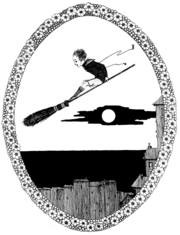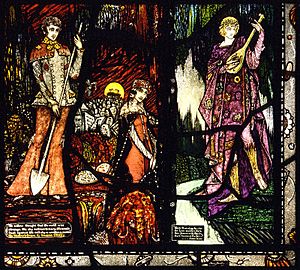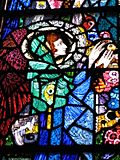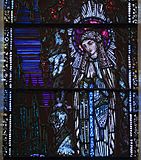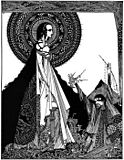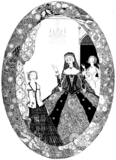Harry Clarke facts for kids
Quick facts for kids
Harry Clarke
|
|
|---|---|
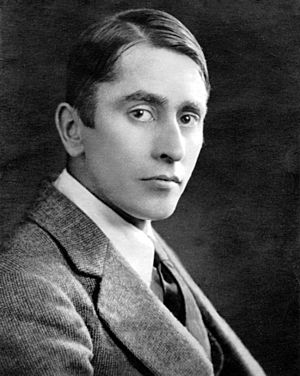 |
|
| Born |
Henry Patrick Clarke
17 March 1889 |
| Died | 6 January 1931 (aged 41) |
| Resting place | Chur (disinterred in 1946 and reburied in an unknown communal grave) |
| Alma mater | Dublin Metropolitan School of Art |
| Known for | stained glass and book illustration |
| Movement | Arts and Crafts |
| Spouse(s) | Margaret Clarke |
Henry Patrick Clarke (born March 17, 1889 – died January 6, 1931) was a famous Irish stained-glass artist and book illustrator. He was born in Dublin, Ireland. Harry Clarke was a very important person in the Arts and Crafts Movement in Ireland.
His art was inspired by different styles like Art Nouveau and Art Deco. His stained glass work was especially influenced by the French Symbolist art movement.
Contents
Early Life and Art Beginnings
Harry Clarke was born on March 17, 1889. He was the younger son of Joshua and Brigid Clarke. His father, Joshua Clarke, had a business in Dublin that decorated churches. Later, this business also started making stained glass. Because of his father's work, Harry learned about many art styles, especially Art Nouveau.
Harry went to school at the Model School and Belvedere College in Dublin. He left school in 1905. When he was only 14, his mother died, which was very sad for him. After school, Harry started working as an apprentice in his father's art studio. He also took evening classes at the Metropolitan College of Art and Design. In 1910, he won a gold medal for his stained glass work called The Consecration of St Mel, Bishop of Longford, by St Patrick.
While studying art, Harry met another artist and teacher named Margaret Crilley. They got married on October 31, 1914. They lived in different places in Dublin and had three children: Michael, David, and Ann.
Harry Clarke's Amazing Career
Illustrating Books
Harry Clarke also worked as a book illustrator. This means he drew pictures for books.
In 1919, he was asked to draw pictures for Ireland's Memorial Records 1914-1918. This was a special book honoring the Irish people who died in World War I. He finished the illustrations for all 8 books in 1922. You can see some of these illustrations at the Irish National War Memorial Gardens.
His first book with his illustrations was Fairy Tales by Hans Christian Andersen in 1916. It had 16 colorful pictures. After that, he illustrated Edgar Allan Poe's Tales of Mystery and Imagination. The 1923 version of this book, with its eight color pictures, made him very famous as a book illustrator.
He also illustrated other books like The Years at the Spring (1920), Charles Perrault's Fairy Tales of Perrault, and Goethe's Faust (1925). His work on Faust is very well-known. He also made special booklets for Jameson Irish Whiskey. His last book, Selected Poems of Algernon Charles Swinburne, came out in 1928.
Creating Stained Glass Art
Harry Clarke made more than 130 stained glass windows. After his father died in 1921, Harry and his brother Walter took over the family art studio.
Harry's stained glass is special because of its detailed drawings and bright, rich colors. He also used the lead lines in the glass as part of the design. He loved using deep blue colors. His black-and-white book illustrations often had strong lines, just like his glass art.
He made many religious windows, but also non-religious ones. Some of his famous religious windows are in the Honan Chapel in University College Cork. For non-religious art, he made a window for John Keats' poem The Eve of St. Agnes, which is now in the Hugh Lane Municipal Gallery in Dublin. Another famous piece is the Geneva Window, made for a building in Geneva, Switzerland. It is now in the Wolfsonian Museum in Miami, USA. You might also know his windows in Bewley's Café on Dublin's Grafton Street.
Later Life and Passing
Harry and his brother Walter both had health problems, especially with their lungs. In 1929, Harry was diagnosed with tuberculosis. He went to a special hospital in Davos, Switzerland. In 1931, he started his trip back to Dublin because he didn't want to die far from home. However, he passed away on January 6, 1931, in Chur, Switzerland, where he was buried. His grave was later moved to a shared burial place in 1946.
Legacy
In 2019, a bridge in Cabra, Dublin was named "Harry Clarke Bridge" to honor him.
Gallery
Stained glass windows
-
"Vision of Bernadette at Lourdes", Church of Saint John the Baptist, Duhill, County Tipperary
Illustrations
-
Illustration for Edgar Allan Poe's "Ligeia", 1923
-
The Fairy, from Fairy tales of Charles Perrault, 1922
Works
As illustrator
- Poe, E. A. - Tales of Mystery and Imagination, George Harrap, London, 1919
- Walters, L. - The Year's at the Spring, George Harrap, London, 1920 The Year's at the Spring via HathiTrust
- Perrault, C. - The Fairy Tales of Charles Perrault, George Harrap, London, 1922
- _____ Ireland's Memorial Records 1914-1918, Maunsel and Roberts, Dublin, 1923
- _____ Jameson The Origin of John Jameson Whiskey, Jameson 1924
- ____ The Elixir of Life Jameson 1925
- Goethe, J. W. von - Faust, George Harrap, London, 1925
- Swinburne, A. C. - Selected Poems of Charles Swinburne, John Lane, London, 1928
See also
 In Spanish: Harry Clarke para niños
In Spanish: Harry Clarke para niños
- An Túr Gloine, a stained glass company Harry Clarke worked with
- Harry Clarke - Darkness In Light


